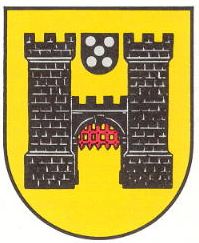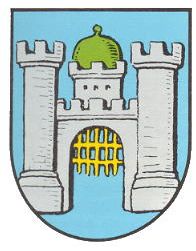Landstuhl
This page is part of the German heraldry portal Deutsche Wappensammlung |
Heraldry of the World |
|
German heraldry:
|
Selected collector's items from Germany:
|
LANDSTUHL
State : Rheinland-Pfalz
District (Kreis) : Kaiserslautern
Verbandsgemeinde : Verbandsgemeinde Landstuhl
| German |
|
| English | No blazon/translation known. Please click here to send your (heraldic !) blazon or translation |
Origin/meaning
The arms are granted on May 28, 1962.
The town was founded near the Nannenstuohl castle and was, like the castle, for a long time a possession and one of the main towns of the Counts of Sickingen. The arms thus show a city gate, with a small shield with the Sickingen arms.
The oldest known seal dates from the middle of the 17th century (known 1637- +/- 1800) and shows a city gate. This seal was still known in the middle of the 19th century and was the base for the grant of the first arms, by King Ludwig I of Bayern on August 3, 1842.
The shape of the gate and the colours were, however, not natural, nor historical. The silver and blue were the colours of Bayern (Bavaria), to which the area belonged in 1842. Hence in 1962 new arms were granted, which more correctly showed the actual gate in the colours of Germany and the Pfalz region. At the same time the small shield with the Sickingen arms was added to reflect the longtime relation of the city with the counts.
There is also a legend regarding the city gate; in a siege in 1537 Count Franz von Sickingen died, but according to the legend the citizens of Landstuhl defended their city and gate fiercely. A later descendent of Franz von Sickingen therefore granted the city the arms with the gate. There is, however, no historical proof of any grant, only the use of the gate on the city seal.
Literature: Debus, 1988; Hupp, 1928



